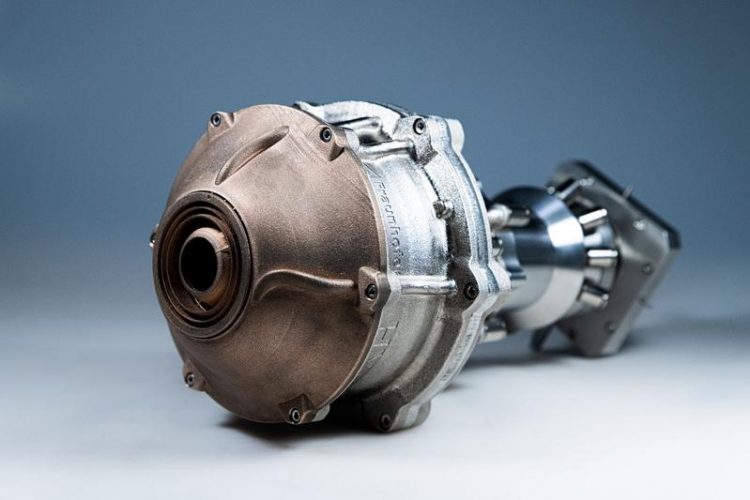Fine-tuning for additive production

“COAXshield” – novel local shielding nozzle system for laser metal deposition applications with sensitive materials © Fraunhofer IWS Dresden
Additive manufacturing systems can generate highly complex components, which could not be produced with conventional machine tools or only with great effort. Nevertheless, such industrial 3D printers are far from being standard equipment in factories.
This is not just due to the purchase costs, but also to many other challenges. The Fraunhofer Institute for Material and Beam Technology IWS Dresden has developed particular solutions and will present them at the “formnext” trade fair in Frankfurt am Main in November 2019.
Included here are “COAXshield”, a local molten pool shield for laser powder build-up welding and the “LIsec” analysis device for controlling the powder flow in additive manufacturing processes.
Titanium, a material popular in aerospace, oxidizes in contact with air at processing temperatures above or equal to 300 degrees Celsius. As a result, the material properties change. The components become brittle and can crack. If, for example, a laser is used by a robot to manufacture a titanium workpiece additively, a large chamber must be built first around the robot and the component.
This chamber is then either flooded with a low-reaction noble gas such as helium or argon or a vacuum must be generated before manufacturing can start.
“This kind of process shielding may be suitable for small component sizes, but it causes considerable difficulties for the production of large components in terms of process control and accessibility,” explains Jakob Schneider, who focusses his research on additive manufacturing at Fraunhofer IWS.
“In addition, the costs for such a chamber increase proportionally with the size of the component to be protected. These are, for example, the expanses for several cubic meters of helium or argon, which may also have to be pumped in and out due to intermediate processing steps.” The same applies to workpieces made of further materials, so-called “refractory metals”, such as tantalum, niobium or titanium-aluminum compounds.
“COAXshield” protects titanium components
For this reason the IWS has developed “COAXshield”, an alternative protective shield designed to direct the shielding gas only to the areas where it is really needed: directly around the laser beam's processing zone, which melts the metal powder and deposits it layer by layer on the component. The nozzle head can be mounted under standard processing optics. It encloses the powder nozzle and forms a protective gas cone “coaxially” around the process zone.
This cone thus only protects the hot processing zone, because just here titanium and ambient air can react with each other.
“This solution saves the user a lot of time and money,” emphasizes Jakob Schneider. “In addition, very large titanium components can also be additively manufactured.”
An example: For the X-ray space telescope “ATHENA”, the European Space Agency ESA needs a satellite supporting structure made of titanium with a diameter of several meters. In cooperation with Fraunhofer IWS, ESA is developing a process and the associated system technology for additive manufacturing. The “COAXshield” has been developed in this context .The technology is expected to be ready for the market at the beginning of 2020.
“LIsec” lights the powder stream
While in conventionally used ablative processes such as milling, the calibration of the tools corresponds to the state of the art, in laser powder build-up welding it is still a great challenge. The “LIsec” measuring device was developed at the IWS to solve this challenge and move the limits to technical feasibility. The abbreviation stands for “Light Section” and reveals the principle: A measuring laser scans the powder flow after leaving the nozzle.
A right-angle camera is mounted, which records light sections through the powder and forwards them to analysis software. “The three-dimensional distribution of the powder stream can be calculated with high precision,” explains IWS engineer Rico Hemschik. “This allows significantly simplified quality control and provides conclusions about the wear degree of the powder nozzle.”
For example, it can be used to repair damaged or worn turbine blades on aircraft in a higher quality and more reliably than before. “In this respect, our measuring device can contribute to greater safety and lower maintenance costs in aviation,” says the IWS engineer. The Dresden Institute is already working on the industrial implementation of the technology with several well-known international companies and research institutes.
VISIT US @FORMNEXT 2019
Fraunhofer IWS will be present at formnext 2019, from November 19 to 22 at Hall 11.0, booth D51 (Fraunhofer). Feel free to stop by.
More info: https://www.iws.fraunhofer.de/en/trade_fairs/formnext_2019.html
Dr. Elena Lopez
Head of department Materials and Failure Analysis
Fraunhofer Institute for Material and Beam Technology IWS
Winterbergstraße 28, 01277 Dresden
elena.lopez@iws.fraunhofer.de
Phone +49 351 83391-3296
https://www.iws.fraunhofer.de/en/pressandmedia/press_releases/2019/presseinforma…
Media Contact
All latest news from the category: Machine Engineering
Machine engineering is one of Germany’s key industries. The importance of this segment has led to the creation of new university degree programs in fields such as production and logistics, process engineering, vehicle/automotive engineering, production engineering and aerospace engineering among others.
innovations-report offers informative reports and articles covering technologies such as automation, motion, power train, energy, conveyor, plastics, lightweight construction, logistics/warehousing, measurement systems, machine tools and control engineering.
Newest articles

An Endless Loop: How Some Bacteria Evolve Along With the Seasons
The longest natural metagenome time series ever collected, with microbes, reveals a startling evolutionary pattern on repeat. A Microbial “Groundhog Year” in Lake Mendota Like Bill Murray in the movie…

Witness Groundbreaking Research on Achilles Tendon Recovery
Achilles tendon injuries are common but challenging to monitor during recovery due to the limitations of current imaging techniques. Researchers, led by Associate Professor Zeng Nan from the International Graduate…

Why Prevention Is Better Than Cure—A Novel Approach to Infectious Disease Outbreaks
Researchers have come up with a new way to identify more infectious variants of viruses or bacteria that start spreading in humans – including those causing flu, COVID, whooping cough…



